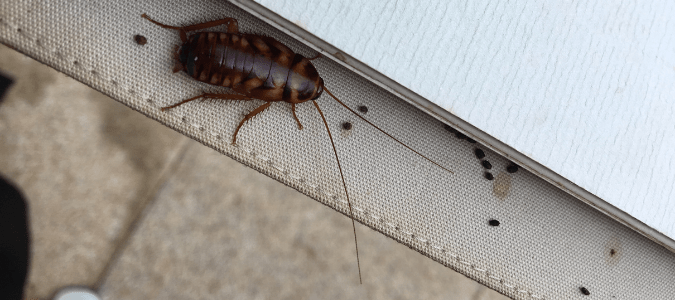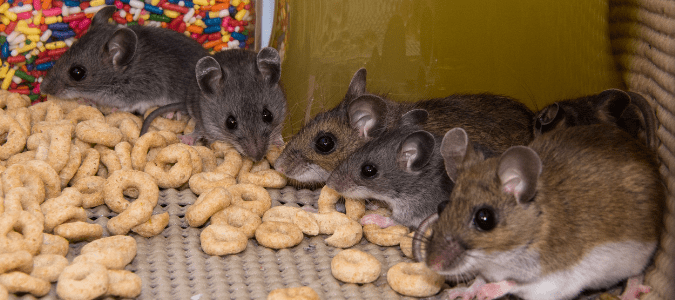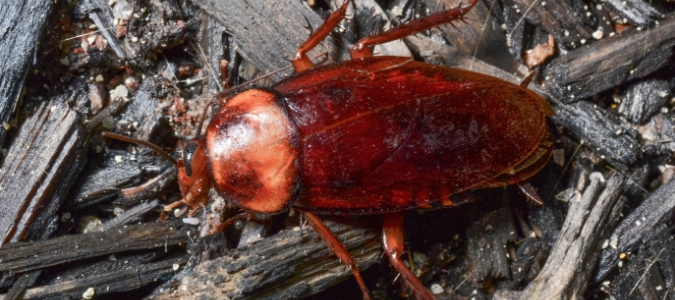When you find strange droppings around your home, you want to know exactly what kind of pest you’re dealing with. Knowing what you’re dealing with is the best way to know how to get rid of an infestation. To identify mouse poop versus roach poop, it’s important to know what each type of poop looks like and where it’s commonly found. Fortunately, there are several key differences between mouse poop and roach poop that can give you clues as to which pest is infesting your home.
Appearance
Both mouse poop and roach poop are medium to dark brown in color. Mouse poop is about the size and shape of dried grains of rice, and poop from bigger roaches can be almost as big as mouse poop. But a key difference between them is that mouse poop is pointed and pinched off at the ends. Roach poop, on the other hand, is more cylindrical with blunter ends. Smaller roaches leave smaller droppings that look more like black pepper or coffee grounds.
Locations
Roach poop and mouse poop can often be found in similar places. Inside or on top of kitchen cabinets, under sinks, or underneath the refrigerator are all common spots for people to find droppings of both of these pests inside their homes. Outdoors, you might spot a mouse or roach poop inside a garage or shed. Roach droppings can actually be anywhere, but they’re especially common near the places where roaches go for food, water, or shelter. This includes hose bibs as well as garbage and compost bins.
Rodent Poop Versus Cockroach Egg Cases
Sometimes, people mistake cockroach egg cases for rodent poop. These egg cases, also called oothecae, are medium or dark brown in color. They are rectangular capsules with hard, shiny exteriors, and sometimes they are banded. Depending on the type and size of roach that laid the egg case, it may be a quarter-inch to half an inch long, and an eighth-inch to a quarter-inch wide.
If you find a roach egg case, you might think it’s some type of pest dropping. It does have some characteristics in common with mouse and rat poop, though there are several key differences between them. Unfortunately, whether you’ve spotted roach cases, roach poop, or mouse droppings, these are all signs of unwanted pest activity.
Even worse, a single home can have both roaches and mice. Mice eat roaches, and both types of pests feed on human foods and garbage. Both mice and roaches are also drawn to paper and cardboard, so both pests can damage books, magazines, and cardboard boxes.
Signs of Mice
There are other signs of roach and mouse activity in a home that can signal an infestation. Besides their droppings, other signs of mice include:
- Gnaw marks on cabinets, baseboards, plastic pipes, drywall, or other areas
- Shredded nesting materials, like paper or fiberglass insulation
- Chew marks on food boxes or scattered foods inside the pantry or cupboards
- Squeaking or scratching sounds coming from inside the walls or ceiling
Signs of Cockroaches
Along with their droppings and egg cases, other signs of cockroaches include:
- Brown dots or smear marks on the walls or any other surface where roaches hang out
- Roach sightings—either adults or babies, and either dead or alive
- An unpleasant, musty smell that may become noticeable with a heavier roach infestation
Whether you have mice or cockroaches, or both, it’s important to get rid of them as soon and as thoroughly as possible. Both mice and roaches pose real health risks to people and their pets. Mice are known to carry potentially harmful bacteria and diseases. Roaches can cause asthma and allergies.
Both pests also contaminate any surface or food that they touch. Mice can also cause extensive property damage through their nesting and gnawing behaviors. An infestation of either pest is something to be taken seriously and treated as soon as possible.
The best way to resolve pest problems is to contact a pest control professional. A specialist can determine exactly what type of pest is infesting your home. Based on this knowledge, they will design a treatment plan that is customized for your home and the people and pets that live there. If you’re dealing with a mouse or cockroach infestation, or both, professional pest control exterminators are the quickest and best way to regain your peace of mind.
What Attracts Mice?
Another important part of resolving a mouse problem is knowing what attracts mice to your property. If you know what’s attracting them, you can take effective steps to keep them away.
To put it simply, when mice enter a home, they are seeking comfortable shelter as well as water and food. If they are able to find all of these things inside your house, they’ll stay and build a nest. This can become a big problem, fast. A single female mouse can have 30 or more babies in a single year! This is how a mouse infestation can so quickly get out of control, and why it’s so important to enlist professional help if you suspect you have a mouse problem.
Preventing Mice
Mice are opportunistic, so if they find a way to get into your home or garage, they will. This is especially true if it’s very hot or cold out, or if their usual outdoor food or water supply is reduced. Mice can use very tiny openings to squeeze into a home. They can get through holes as small as the width of a pencil. Closing off these little gaps is a very important part of keeping mice away.
Another key part of preventing mice from infesting your home and property is getting rid of what is attracting them. Both inside and outside the home, it’s important to make sure your compost and garbage bins have tightly fitting lids. Pet food and water bowls should also be emptied out each night so they won’t draw mice and other pests. It’s also important to fix any leaking faucets or pipes, so mice don’t have these available as a ready water supply.
Inside the home, all food should be kept in containers with airtight lids that mice can’t chew their way through. This goes for pet food as well as people’s food. Getting rid of clutter is another way to deter mice from moving in. These pests often use cardboard storage boxes, stacks of magazines, and other clutter as nesting materials as well as handy hiding places when needed.
Spotting an actual mouse in the home is rare, since these animals are mostly active at night, under the cover of darkness. They are also naturally wary of people as well as dogs, cats, and other potential predators. But while you may never spot an actual mouse, you might have a mouse problem. If you find mouse droppings, gnaw marks, chewed cereal boxes or cardboard boxes, or any other signs of mouse activity, it’s time to contact a wildlife rodent control professional who can determine the best ways to get rid of these pests.
Does Mulch Attract Roaches?
Sometimes people ask pest control professionals: Does mulch attract roaches? The short answer is that yes, roaches are attracted to mulch. In fact, many types of cockroaches love to nest, feed and breed in mulched garden beds outdoors.
Mulch actually provides the perfect environment for roaches. It gives them visual protection from potential predators as well as environmental protection from the weather. The mulch keeps them cooler in the heat of summer, and warmer during the fall and winter months. It allows water to drain quickly, so the roaches won’t drown, but it holds in enough moisture for them to drink. Mulch can also foster the growth of rich organic matter, which roaches love feeding on. Certain types of roaches actually consume decaying wood, so as the mulch breaks down over time, it creates a great meal for these pests.
Cockroaches aren’t the only type of pest that is drawn to mulch. Termites can also feed on mulch and even build their subterranean colonies beneath mulched garden beds. Ants sometimes build ant piles in mulch, and spiders, centipedes, and earwigs might also be right at home in piles of mulch.
Mulch can be very beneficial in a yard. It helps plants and trees whether through extreme temperatures and retains the moisture they need to thrive. It can also act as a natural weed barrier, cutting down on the growth of undesirable, fast-growing, opportunistic plants in your garden.
But mulch can also harbor several different kinds of unwanted pests. If you have mulch in your yard, it’s a good idea not to spread mulch too close to the house. Instead, keep a one-foot barrier between the foundation of the home and the edge of any mulched bed. This will help to keep cockroaches away from your home, not to mention termites and other pests.
A pest control professional can give you advice on any areas of your yard that might be attracting roaches or other pests. They can offer tips on ways to keep pests away, so you can have a beautiful garden without accidentally creating the perfect conditions for a cockroach infestation.
ABC Can Control the Pests on Your Property
Both mice and cockroaches are extremely difficult to control. If you have noticed these pests or the signs of their activity, contact ABC Home & Commercial Services. Our professionals will create a custom rodent control plan, so you don’t have to worry about unwanted creatures on your property.


